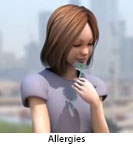
Food Allergy Testing
________________________________________________________________________
KEY POINTS
- Food allergy testing is a way to check how your child’s body reacts to certain foods.
- Different kinds of tests may be done, such as blood tests, skin prick tests, or avoiding certain foods for a time.
- Food allergy testing will help you know which foods your child should avoid eating to prevent an allergic reaction.
________________________________________________________________________
What is food allergy testing?
Food allergy testing is a way to check the body's reaction to certain foods. Along with a medical history and physical exam, one or more of these tests may be done to see what foods your child may be allergic to:
- Elimination diet
- Skin prick test
- Blood test
- Food challenge test
Why is it done?
If your child has had allergic symptoms after eating certain foods, your healthcare provider may suggest that your child have tests to check for food allergies. This will help you know which foods your child should avoid eating to prevent an allergic reaction. The most common foods that cause allergies are milk, soy, eggs, peanuts, tree nuts, fish, shellfish, and wheat.
Your child may need to be tested for food allergies if your child has some of these symptoms within a few minutes or as long as 6 hours after eating:
Mild symptoms:
- Sneezing
- Itchy, watery eyes and swollen eyelids
- Stuffy or runny nose
- Red, raised, itchy areas on the skin (hives)
- Nausea or stomach cramps
Severe symptoms:
- Trouble talking, trouble breathing, and wheezing
- Fast heartbeat
- Swelling of the lips, tongue, or throat
- Feeling very anxious or confused
- Feeling dizzy or faint
- Vomiting or diarrhea
How do I prepare my child for the tests?
Your child may need to avoid taking certain medicines, such as antihistamines or steroids, before the test because they might affect the results. Make sure your healthcare provider knows about any medicines, herbs, or supplements that your child takes. Don't stop any of your child’s regular medicines without first checking with your healthcare provider.
Talk to your healthcare provider if you have any questions.
How are the tests done?
One or more of the following tests may be done.
Elimination diet: Your healthcare provider may want your child to stop eating foods that your child may be allergic to for a week or two. Then you will add the foods back into your child’s diet one at a time. This process can help connect your child’s symptoms to specific foods. During this time, you will need to keep a record of the foods your child eats and any symptoms your child has. If your child has had a severe reaction to foods, this method cannot be used for diagnosis.
Skin prick test: A skin prick test is often used to help identify food allergies. For this test, a drop of food extract is put on your child’s skin and then the skin is pricked with a small needle through the drop of the food extract. The test can also be done with a pricking device that has been presoaked in the food extract. Only the top layer of skin is pricked. The test is usually done on your child’s back or arm. The skin test is ready to check in about 15 minutes. Your child may be allergic to the food if a red bump appears at the spot where the food extract was placed. This test by itself is not enough to diagnose a food allergy.
Blood test (RAST test): Blood tests are not done as often as skin prick tests. Blood tests are sometimes done on babies less than 1 year old because their skin does not react to the prick test as well as it does for older children. The RAST test checks a sample of your child’s blood for antibodies the body makes when it is trying to fight off allergy-causing substances in foods. This test by itself is also not enough for a diagnosis.
Both skin and RAST tests may show that your child is allergic to a food that further tests show he is not allergic to (false positive results). A food challenge test may be needed to confirm the results.
Food challenge: A food challenge test may also be used to diagnose a food allergy. The test is usually done in your healthcare provider’s office. Sometimes it is done in the hospital. To do the test, your child is given gradually increasing amounts of a food-- either in colorless capsules or in another food, such as pudding --while your provider watches for symptoms. This test should be done only by a trained professional who is ready to treat your child if he has a serious reaction to the food. If your child has symptoms of an allergy after the challenge, the diagnosis can be made. The food challenge is also good way to see if your child has outgrown an allergy.
Ask your healthcare provider how you will get the result of your child’s skin prick or blood test.
What do the test results mean?
If the skin or blood test is negative for a food, then your child probably does not have an allergy to that food.
If the skin test is positive for a certain food, it may mean your child is allergic to that food.
Sometimes the test can be positive even if your child is not allergic to the food. The test result may be wrong because:
- Your child can continue to have a positive test result for many years after he has outgrown a food allergy.
- Your child is allergic to something similar to the food he or she was tested for. For example, your child might have a positive test for soy if she has a peanut allergy, or a positive test to wheat, if he has a grass pollen allergy.
What if my child’s test result is not normal?
Test results are only one part of a larger picture that takes into account your child’s medical history and current health. Sometimes a test needs to be repeated to check the first result. Talk to your healthcare provider about your child’s result and ask questions such as:
- If your child needs more tests
- What kind of treatment your child might need
- When your child needs to be tested again
- What lifestyle, diet, or other changes you might need to make
For more information contact:
- The American Academy of Allergy, Asthma and Immunology
http://www.aaaai.org/ - Food Allergy Research & Education (FARE)
http://www.foodallergy.org
Last modified: 2015-07-21
Last reviewed: 2017-06-16


